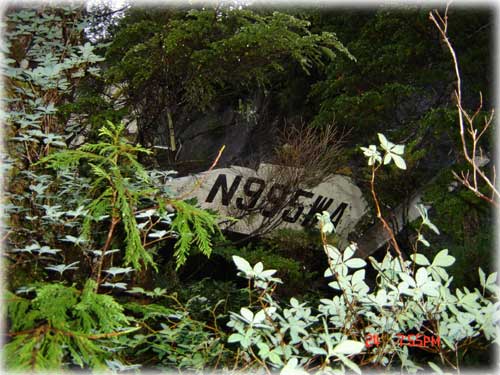 August 17, 2008
Killed were the pilot, Joseph Campbell, 56, and two married couples who were passengers on the Sun Princess: William F. Eddy and Jeanne J. Eddy, both 59, of Jacksonville, Fla., and Paul J. McManus, 60, and his wife, Marianne M. McManus, 56, of Massachusetts. Mrs. McManus and Mrs. Eddy were sisters.  Photograph courtesy Alaska State Troopers
According to the NTSB's report, the crashed air taxi float-equipped airplane was the second of three airplanes on an air tour flight over a remote scenic area in southeast Alaska. As the flight of three airplanes flew into mountainous terrain, the first pilot reported low clouds, with rain and fog, which required him to descend to 700 feet feet msl (Altitude above Mean Sea Level), to maintain VFR flight conditions. The pilot of the third tour airplane, which was about 5 minutes behind the accident airplane, stated that as he approached the area around the accident site, he encountered "a wall of weather" which blocked his intended flight route, and he turned around. The accident airplane's fragmented wreckage was discovered in an area of steep, tree-covered terrain, about 2,500 feet msl (Altitude above Mean Sea Level), near the area where the third airplane turned around. The NTSB discovered no mechanical problems with the airplane during postaccident inspections. An NTSB weather study revealed instrument meteorological conditions in the area at the time of the accident. Photographs recovered from a passenger's camera depicted deteriorating weather conditions as the flight progressed. A charter boat captain, who had seen numerous float-equipped tour airplanes operating in adverse weather conditions, called the local FAA Flight Standards District Office (FSDO) 9 days before the accident, to report his sightings. Probable cause findings by the NTSB reveled that according to the Federal Aviation Administration (FAA), no specific tour operator could be identified during the FAA's ensuing investigation, and no enforcement actions or additional surveillance of any operators was initiated by the FAA. According to the FAA Flight
Standards District Office manager, the local FAA Flight Standards
District Office had lost inspectors due to downsizing. The manager
reported they had not attempted to observe operators' adherence
to weather minimums via ground-based viewing locations along
the heavily traveled tour routes, and noted that FAA inspectors
used to purchase air tour tickets to provide en route, on-board
surveillance, but had not done so for approximately the last
10 years. He noted that additional inspector assistance from
other FAA offices was not requested.
On the Web:
Source of News:
Publish A Letter in SitNews Read Letters/Opinions
|